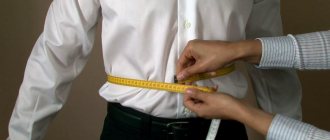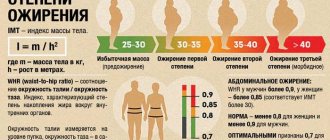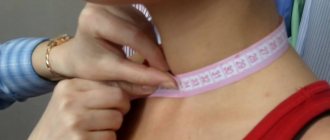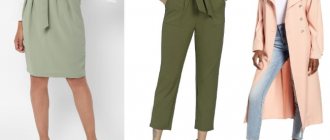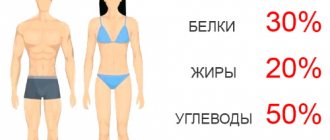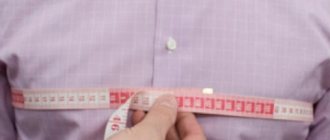Waist size in men is not only an important indicator of how the figure develops and what is the state of health. This is also one of the necessary measurements in choosing the right clothing size. Therefore, many people actively use size tables with waist measurements for men.
When starting the process of losing weight, going on a diet, planning to order clothes, as well as doing exercises at home or in the gym, it is important to accurately and correctly measure the contours of the body. Why? When deciding to lose weight or build muscle, you need to know your starting point. For this purpose, tables with normal age and weight are used to measure waist size in men.
How to measure
This type of measurement is not difficult, but there are a few basic principles to keep in mind. First of all, correct body position is important.
The waist is slightly below the level of the ribs and just above the navel. When measuring yourself, it is better to do it in front of a mirror. A correctly taken measurement is obtained when measuring a centimeter around the narrowest part of the body. The centimeter is applied horizontally. In addition, during the measurement you should be in a standing position, you must first exhale. Moreover, you need to ensure that the centimeter does not fit too tightly or too loosely around the body. It is best to take measurements with an accuracy of 0.5 cm. Of course, measurements are never taken while wearing clothes; in order for the result to be accurate, you need a naked body. Measurements should not be taken immediately after a heavy meal. The results in this case will be erroneous.
After several months of struggling with excess pounds, after liters of sweat shed in the gym, sometimes you get the feeling that little has changed in your silhouette. Checking the waist size in men using a table approximately every 2 weeks allows you to understand whether the training is actually bringing results. The centimeter doesn't lie.
Measuring is a much more accurate tool for tracking progress than weighing yourself. Human body weight is constantly subject to small or large changes. This is influenced by the fact that we live under stress, sometimes we eat more than we need, we drink a lot, or, conversely, we suffer from dehydration, for example, during illness. Weight is constantly changing.
Measuring chest circumference
If you want to sew a jacket or shirt, you need to know your measurements and we will start with the chest circumference. To determine your chest size, all you need is a measuring tape and a pencil to write down. Wrap the tape around your chest and measure at the widest part. If you want more details, read on.
First we need a measuring tape . This is the most convenient tool for taking such measurements. If you don’t have tape on hand, take a thick thread (you can use wool for knitting) and measure the volume with it. Then attach the thread to the ruler and get the required numbers. measure your breast size.
Call for help from a friend , mother, sister, husband or anyone who can hold a measuring tape in their hands. Since it is not very easy to carry out such measurements on your own. If you don’t have an assistant at hand, you’ll have to get a little creative, but this is also possible. Just make sure the tape doesn't slide across your back as you measure. measure breast size
Take off your shirt (jacket, blouse, any outerwear), but leave your bra on. Any additional fabric will add extra volume to you. Since you will be wearing your bra under clothing, your bra size should be included in your measurements. measure breast size
Wrap the measuring tape around your chest . Position it so that the tape is horizontal to the ground and under your armpits. Position the tape so that it goes across the widest part of your chest. Don't hold your breath, stand straight and relaxed. Make sure the tape is not twisted. measure breast size
Look in the mirror to see the measurement result. Or pinch the intersection of the tape with its beginning with your fingers and find out the girth of your chest. For some products you will also need to measure the circumference under the bust. Measurements are taken using the same principle, directly under the bust.
Rules
They examine the waist size of men for the clothing size they are going to select in the morning on an empty stomach, before the person eats or drinks anything. They do not measure clothing.
You need to stand with your feet hip-width apart, relax your body, including your gluteal muscles, and breathe calmly. You will need to straighten your back. It is important not to pull your stomach in too much.
When taking measurements, it is best to start at the top of the body and work your way down.
To compare waist size in men with the norm in the table, measurements are taken at the narrowest point of the torso. It is necessary to ensure that the person does not suck in his stomach. Waist circumference is measured approximately at the navel or slightly below.
Measuring chest circumference
Your waist size is an important measurement used in everything from choosing clothes to figuring out if you're overweight. Luckily, it's easy to measure and you can do it with a regular measuring tape.
In short, To find out your waist size, first lift or take off your shirt (T-shirt, blouse, it doesn’t matter), then stand straight and exhale. In this position, hold the end of the measuring tape at your belly button and wrap it around the narrowest part of your waist. Make sure the measuring tape fits snugly against your body and is parallel to the ground. The tape should intersect with its beginning. At the intersection we get your waist size.
Remove or lift clothing . To take accurate measurements, you need to make sure that the measuring tape touches your bare stomach. We remove all clothes that might interfere with us.
Find your waist . Use your fingers to find the top of your thighs and the base of your ribcage. Your waist is the soft, fleshy area between these two bony parts. It is also the narrowest part of your body and is often at or just above your belly button.
Wrap a measuring tape around your waist . Stand up straight and breathe deeply and calmly. Hold the beginning of the measuring tape at your belly button and trace it around your waist. The measuring tape should be parallel to the floor and fit snugly against your body without cutting into your skin. Make sure the measuring tape is straight and not curled anywhere, especially at the back.
We get measurements . Exhale and then check the measurements on the tape. The number indicating the size of your waist will be at the place where it comes into contact with the zero mark (the beginning of the tape).
Double check your measurements. Repeat the measurement again to get an accurate result. If it is different from the first time, measure it a third time and take the average of the three numbers.
Meaning
Most people think that body weight is an indicator that determines the effectiveness of training or the degree of obesity. However, in reality, mass says little about the results of training. Body contour measurements are important; athletes recommend taking them every 1-2 weeks in the morning on an empty stomach. Based on their changes, the training program is adjusted, as well as the amount of calories in the diet. Or they select suitable clothes and sew new ones. Measurements of body contours should be performed in a standing position, slightly tensing the muscles, to avoid possible errors due to excessive relaxation of the body.
Character.
Women with a wider waist are characterized by “masculine behavior.” Visceral obesity is associated with an increase in testosterone. And for men it’s the opposite. According to Cashdan, in countries where women occupy a subordinate position in economic terms (Japan, Portugal, Greece), thin waists are more common among local residents. In countries with pronounced gender equality (Denmark, Great Britain) the situation is exactly the opposite.
Relationship with mass
To make it easier to figure out which direction to move, there is a norm table for men’s waist size. It takes into account the relationship of this indicator directly with body weight.
In order to compare a man’s waist size with the norm in the table, you only need a centimeter. But to determine the degree of obesity, you also need scales. The calculation is made as follows: body weight in kilograms is divided by height expressed in meters. However, there is a second method that uses waist measurements for men, the norm table.
It checks the ratio of waist circumference to hip circumference. You will need to measure your waist circumference (3-5 cm above the navel), as well as your hip circumference at the widest point. Then divide the waist circumference by the hip circumference. For example, a person with a waist circumference of 86 cm and a hip circumference of 96 cm has an index of 0.8.
This is how an indicator called WHR (Waist/Hip Ratio) is calculated. It expresses the ratio of waist circumference to hip circumference and determines body type and degree of obesity. If it is equal to/above 0.8 in women or equal to/above 1.0 in men, we are dealing with apple-type obesity, also called abdominal obesity. This is the most dangerous type of obesity, which is prone to the development of cardiovascular diseases and many other serious ailments. If the indicator value is less than 0.8 in women and 1.0 in men, we are talking about less serious obesity - pear-type obesity. But this does not mean that it does not increase health risks.
Measuring the hips
Accurate hip measurements are important for tailoring. To measure your hips, remove your outer clothing, place your feet together, take a measuring tape, and wrap it around your hips at the widest part. The point where the tape will intersect with its beginning will be the volume of your hips.
Detailed instructions on how to measure your hips:
Find a full-length mirror . Although it is easier to measure your hips yourself than other parts of the body, a mirror will help you make sure that the measuring tape is not twisted. But even without a mirror everything will work out.
Take off your clothes. Take off your outerwear: trousers, skirt, dress, etc. Because no matter how thin it is, it will add extra volume to you. We leave the linen, because... we always wear it.
Place your feet together . Standing with your legs apart will not give you an accurate result. The maximum can be placed at shoulder width, but it is better together.
Hips not waist . It sounds stupid, but sometimes people confuse these concepts. The waist is the narrowest part of your body from your shoulders to your butt. The hips are the widest part below the waist.
We are looking for the widest place . To obtain the volume of the hips, we are looking for their widest part. For a perfect fit of future clothing, it is very important to find the widest part. To do this, we use a measuring tape, placing it lower or higher by a centimeter until you find the desired point.
Take a measuring tape . Hold one end of the tape on one hip. It doesn't matter which side you start from. You can also pull it closer to the middle if that makes it easier for you.
Wrap the tape around your hips . Just make sure the tape doesn't twist.
Look in the mirror . Make sure the tape is level and parallel to the floor.
Press the tape against your body. The tape should not dig into the skin or dangle loosely. You can use your finger as a tension gauge. Only one finger should be placed between the body and the tape.
We get the result. We use a mirror to see the result while the tape is on the hips, or we press our fingers where the tape intersects with its beginning. We record the measurements. Now we know the volume of the hips. But for sewing clothes we will need other parameters, for example, hip circumference. Like volume, hip circumference is measured at the widest part of the leg.
- Like your hips, you measure your thigh at the thickest part of your leg.
- The inseam length of the trousers is determined along the inside of the leg from the crotch to the place where the trousers should end. If you already have trousers of a suitable length, you can determine the length of the inseam using them.
Add a few centimeters when sewing. When you sew clothes, you should not use the measurements taken as is, as the clothes should not be too tight, otherwise it will be difficult for you to move. Therefore, to make clothes comfortable, you should add a couple of centimeters to your measurements.
- It is necessary to slightly increase the value of the measurements for two reasons. The first and already mentioned is that the clothes are comfortable. And the second is that an increase in measurements may be required to create a new clothing design. For example, you want to sew a full, flowing skirt, and then you will need to increase the hip measurement much more than when sewing an a-line skirt.
- The elasticity of the fabric used for sewing also affects the allowance used. If the fabric stretches very well, then you probably don't need to add much more.
- Most ready-made patterns will have instructions that tell you how many extra inches you should add to your measurements to determine the size you need. However, if you are making a pattern yourself, then it would be better for you to add 5-10 cm to the volume of your hips (depending on how tight you want the clothes to be).
- If you are a plus-size person, then to provide additional freedom of movement, you can further increase your hip measurement. Remember, when buying fabric, look at its composition, if possible, touch it in person. If it contains elastane or other additives that give it a stretch effect, this must be taken into account when sewing.
Remember, when buying fabric, look at its composition, if possible, touch it in person. If it contains elastane or other additives that give it a stretch effect, this must be taken into account when sewing.
admin
All articles
What does waist circumference mean?
Waist circumference itself is also an important indicator of health. The normal waist circumference for women is 80 cm; for men, 94 cm is considered normal. Values above 88 cm in women and 102 cm in men indicate the possibility of developing breathing problems, hypertension, high cholesterol, and the risk of developing diabetes and heart failure. It is also important to study the accumulation of subcutaneous fat.
Size ranges of Russian and foreign manufacturers
The same numerical designation of dress size in different clothing lines can correspond to completely different waist and hip measurements. This is understandable, since Russian and foreign manufacturers have different size ranges.
The tips below may help you when buying clothes in a retail or online store:
- To decide on the choice of item according to European standards, subtract 6 from its size. Then it turns out that, for example, a 36th size will fit your Russian size 42. This applies to all of “Europe” except England.
- If you want to buy American items, subtract from size 34. Then an American size 8 will fit the usual 42. The same applies to items from England (the size chart is the same as the American one).
- When ordering clothes on Asian websites (Ali Express, Joom, etc.), pay attention not only to the size, but also to the height. The manufacturer must indicate that it complies with international standards. If there is no such clause, it is better not to take risks, since Asians are shorter than the average European. Clothes may not fit.
Moreover, even Russian clothing sizes may differ from one manufacturer to another by 1-2 cm. Therefore, every time you choose a new item, you should have a grid of sizes in front of you.
Size chart for women's outerwear: jackets, down jackets, coats and raincoats
The sizes of outerwear for women are determined by the parameters of the chest and waist. To take measurements, you don’t need to “throw on” too much so that there is a “reserve”. The manufacturer has already calculated the required volume for your size, taking into account the fact that this is outerwear.
| Chest (cm) | Waist (cm) | Hips (cm) | Sleeve(cm) | Russian size | International size | England | USA | Europe | Italy | Japan |
| 76 | 58 | 82 | 58/60 | 38 | XXS | 30 | 0 | 32 | 36 | 3 |
| 80 | 62 | 86 | 59/61 | 40 | XS | 32 | 2 | 34 | 38 | 5 |
| 84 | 66 | 92 | 59/61 | 42 | S | 34 | 4 | 36 | 40 | 7 |
| 88 | 70 | 96 | 60/62 | 44 | M | 36 | 6 | 38 | 42 | 9 |
| 92 | 74 | 100 | 60/62 | 46 | M | 38 | 8 | 40 | 44 | 11 |
| 96 | 78 | 104 | 60/62 | 48 | L | 40 | 10 | 42 | 46 | 13 |
| 100 | 82 | 108 | 61/63 | 50 | L | 42 | 12 | 44 | 48 | 15 |
| 104 | 86 | 112 | 61/63 | 52 | XL | 44 | 14 | 46 | 50 | 17 |
| 108 | 90 | 116 | 61/63 | 54 | XXL | 46 | 16 | 48 | 52 | 19 |
| 112 | 94 | 120 | 61/63 | 56 | XXL | 48 | 18 | 50 | 54 | 21 |
| 116 | 98 | 124 | 62/64 | 58 | XXXL | 50 | 20 | 52 | 56 | 23 |
| 120 | 100 | 128 | 62/64 | 60 | 4XL | 52 | 22 | 54 | 58 | 25 |
| 124 | 104 | 132 | 62,5/65 | 62 | 4XL | 54 | 24 | 56 | 60 | 27 |
| 128 | 108 | 136 | 62,5/65 | 64 | 4XL | 56 | 26 | 58 | 62 | 29 |
| 132 | 112 | 140 | 62,5/65 | 66 | 5XL | 58 | 28 | 60 | 64 | 31 |
| 136 | 116 | 144 | 62,5/65 | 68 | 5XL | 60 | 30 | 62 | 66 | 33 |
| 140 | 120 | 148 | 62,5/65 | 70 | 5XL | 62 | 32 | 64 | 68 | 35 |
Size chart for women's trousers, pants and skirts
To choose the right pants size, you need to know exactly the measurements of your waist and hips.
| Russian size | International size | Waist(cm) | Hip circumference (cm) | England (UK) | USA (US) | Europe (EU) | Italy (IT) | Japan (JP) |
| 38 | XXS | 58 | 82 | 4/30 | 0 | 32 | 36/0 | 3 |
| 40 | XS | 62 | 86 | 6/32 | 2 | 34 | 38/I | 5 |
| 42 | S | 66 | 92 | 8/34 | 4 | 36 | 40/II | 7 |
| 44 | M | 70 | 96 | 10/36 | 6 | 38 | 42/III | 9 |
| 46 | M | 74 | 100 | 12/38 | 8 | 40 | 44/IV | 11 |
| 48 | L | 78 | 104 | 14/40 | 10 | 42 | 46/V | 13 |
| 50 | L | 82 | 108 | 16/42 | 12 | 44 | 48/VI | 15 |
| 52 | XL | 86 | 112 | 18/44 | 14 | 46 | 50/VII | 17 |
| 54 | XXL | 90 | 116 | 20/46 | 16 | 48 | 52/VIII | 19 |
| 56 | XXL | 94 | 120 | 22/48 | 18 | 50 | 54/IX | 21 |
| 58 | XXXL | 98 | 124 | 24/50 | 20 | 52 | 56/X | 23 |
| 60 | 4XL | 100 | 128 | 26/52 | 22 | 54 | 58/XI | 25 |
| 62 | 4XL | 104 | 132 | 28/54 | 24 | 56 | 60/XII | 27 |
| 64 | 4XL | 108 | 136 | 30/56 | 26 | 58 | 62/XIII | 29 |
| 66 | 5XL | 112 | 140 | 32/58 | 28 | 60 | 64/XIV | 31 |
| 68 | 5XL | 116 | 144 | 34/60 | 30 | 62 | 66/XV | 33 |
| 70 | 5XL | 120 | 148 | 36/62 | 32 | 64 | 68/XVI | 35 |
If in the size comparison table your volume is at the junction of two sizes, take into account the style of trousers or skirts.
Women's jeans size chart
When choosing jeans, you also need to know your waist and hip measurements. If the jeans are stretch, do not take models with “reserve”. When worn, they will stretch and become incredibly large.
| Russian size | International size | Waist(cm) | Hip circumference (cm) | Waist (inches) | USA |
| 38 | XXS | 58 | 82 | 24 | 0 |
| 40 | XS | 62 | 86 | 25 | 0-2 |
| 42 | S | 66 | 92 | 26 | 2 |
| 42 — 44 | S/M | 66 — 70 | 92 — 96 | 27 | 2 — 4 |
| 44 | M | 70 | 96 | 28 | 4 |
| 44 — 46 | M | 68 — 74 | 96 — 100 | 29 | 4 — 6 |
| 46 | M | 74 | 100 | 30 | 6 |
| 46 — 48 | M/L | 74 — 78 | 100 — 104 | 31 | 6 — 8 |
| 48 | L | 78 | 104 | 32 | 8 |
| 48 — 50 | L | 78 — 82 | 104 — 108 | 33 | 8 — 10 |
| 50 | L | 82 | 108 | 34 | 10 |
| 50 — 52 | L/XL | 82 — 86 | 108 — 112 | 35 | 10 — 12 |
| 52 | XL | 86 | 112 | 36 | 12 |
| 54 | XXL | 90 | 116 | 38 | 14 |
| 56 | XXL | 94 | 120 | 39 | 16 |
| 58 | XXXL | 98 | 124 | 40 | 18 |
| 60 | 4XL | 100 | 128 | 41 | 20 |
| 62 | 4XL | 104 | 132 | 42 | 22 |
| 64 | 4XL | 108 | 136 | 43 | 24 |
| 66 | 5XL | 112 | 140 | 44 | 24 |
Subcutaneous fat examination
You need to relax your stomach, and then, at a close distance from the navel, pinch the skin between two fingers. If it has a thickness greater than 2.5 cm, this means that the accumulation of subcutaneous adipose tissue is excessive. It is necessary to get rid of it in the near future.
These simple measurements will indicate whether there is cause for concern and how urgent action needs to be taken to maintain health and well-being.
Cardiovascular health.
Waist size quite reliably indicates an increased risk of hypertension, diabetes and high cholesterol. Studies have confirmed that health risks begin to increase if a woman's waist reaches 80 centimeters; at 89 centimeters it increases significantly. For men, the risk increases from 94 centimeters. Then we will talk about adjusting for height, because these are relative figures, and they are not suitable for people who are too tall or too short, for children, and also for representatives of some ethnic groups. For example, among the Japanese, the risk increases sharply if the waist size in men reaches 85 centimeters, and in women - 90 centimeters. The risk of stroke is increased sevenfold.
How often should you measure your waist?
It is recommended to examine this issue at least twice a week. When fat accumulates in the abdomen - on and around the internal organs - fat cells release chemicals that cause inflammation and produce proteins associated with appetite. In addition, insulin resistance increases and the likelihood of metabolic disorders increases as inflammation affects muscle and liver cells. Their functions may be inhibited. Meanwhile, the natural appetite regulation system does not work properly, leading to overeating and increased belly fat.
Measuring your waist with a tape measure is a good indicator of the amount of belly fat.
Causes of a large waist circumference
Endocrinologists treat obesity, including visceral obesity.
But very often we need the help of colleagues: gastroenterologists, gynecologists, nutritionists, oncologists, surgeons. Since an increase in waist circumference does not always mean an accumulation of visceral fat! There are other situations that are quite dangerous for humans, which may be accompanied by an increase in this indicator. Let's look at some of them.
- Ascites. This is the name given to the accumulation of free fluid in the abdominal cavity. It may develop slowly and unnoticed over several months. Detection of ascites by conventional clinical methods (inspection, palpation, percussion) is possible only with a significant amount of free fluid (several liters). In the early stages, a good assistant in diagnosis is the ultrasound method.
- Flatulence. Intestinal bloating is one of the common causes of abdominal discomfort that occurs with an increase in waist circumference. Treatment of diseases of the gastrointestinal tract accompanied by bloating leads to a rapid and significant change in volume downward.
- Tumors. Some formations of the abdominal cavity and pelvic organs can reach significant sizes and affect the configuration of the abdomen. In some cases, even upon examination and palpation it is possible to suspect which organ this formation is growing from. The diagnosis is clarified using research methods such as ultrasound, CT, MRI.
- Spine pathology. Diseases that occur with a decrease in the height of the vertebrae and intervertebral discs can have a significant impact on the waist. For example, with compression fractures, the ribs may descend towards the pelvic bones until they touch. This leads to displacement of internal organs, changes in the tone and configuration of the muscles of the anterior abdominal wall, and deformation of not only the spine, but also the entire torso.
- Press. The condition of the muscles of the anterior abdominal wall is a modifiable factor, which is significantly influenced by physical activity. A well-chosen training regimen can significantly reduce your waist circumference. But, in case of problems such as diastasis, hernias, consultation with a surgeon and surgical treatment may be required.
So, a simple and understandable method that can be done at home can direct you to consult a specialist. Bearing in mind that obesity is a disease, and not just a feature of the figure, in the fight against it you should start with a visit to an endocrinologist.
Author of the article: ASTAFYEVA MARIA ALEXANDROVNA – ENDOCRINOLOGIST, CATEGORY I
